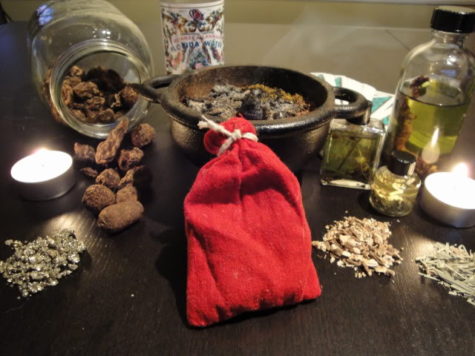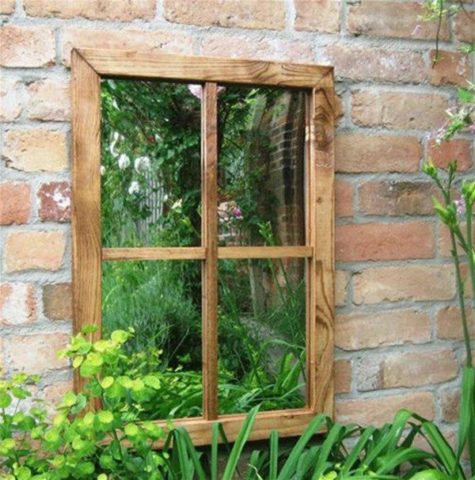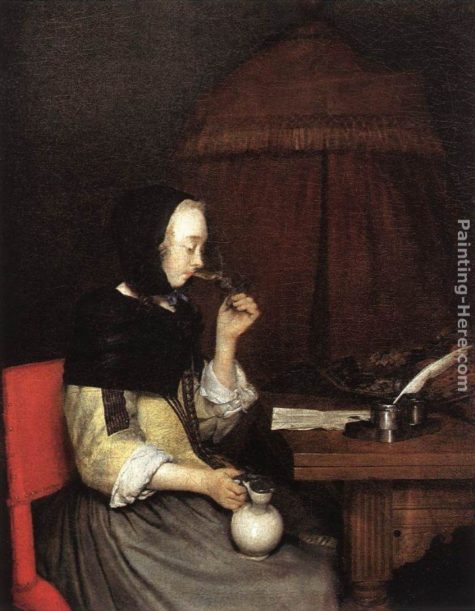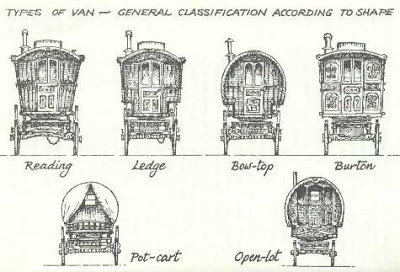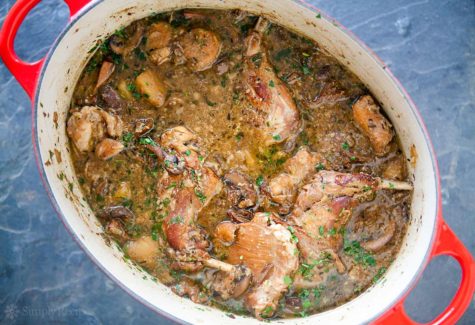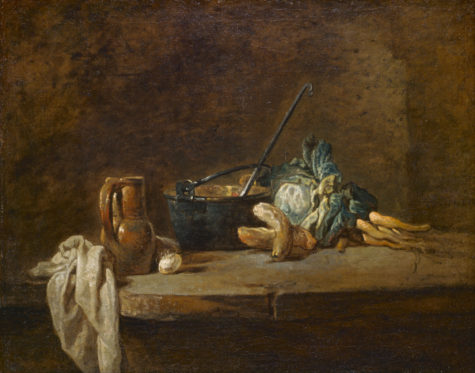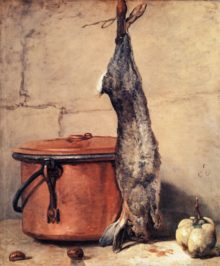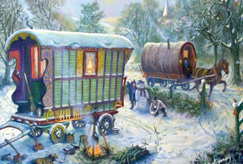Monthly Archives: January 2017
Make A Gypsy Mojo Bag
A Parik-til is the Gypsy version of a medicine or mojo bag. To create a parik-til, a small drawstring pouch is made in the appropriate color for the intended purpose. Into this goes various little objects: herbs, stones, feathers, sometimes a charm or piece of paper inscribed with a simple spell. This list is endless; it is only important that the objects seem sympathetic to your purpose.
Collect leaves and twigs of the oak tree, including a small acorn if available, the petals and/or seeds of the sunflower, a piece of cinnamon stick, three cloves, a stone that feels lucky for you, a horseshoe charm if you can find one – or a small picture or hand drawn symbol to represent a horse shoe, and a little trinket such as a bit of jewelry or a coin.
Feel free to add anything else that seems relevant, or meaningful to you. Tie the oak leaves and twigs with a bit of green yellow and orange thread. Put all the items into a drawstring bag. Perfume with an essential oil such as Myrrh, Benzoin, Cinnamon, or Patchouli, or dab with prosperity oil.
Hold the bag in your hands and feel the energy contained within. Parik-til means blessing holder, the objects inside the bag are symbols of the blessings you are holding. Take a few minutes to allow yourself to really feel it.
If you have never made a simple drawstring bag, they are super easy, and you can find hundreds of tutorials online, or you can check out my less than artistic rendition of how to make a drawstring pouch in about 5 minutes using a handkerchief, a ribbon, and a needle and thread. Here’s the link: How To Make A Simple Mojo Bag
Adapted from: Gypsy Magic by Patrinella Cooper
Making Miracles Happen
Gypsies are famous for their “happy go lucky” attitude. Here is a small but significant “affirmation” or “charm” to do each morning. Begin your day by saying out loud and with conviction:
“A miracle is going to happen today.”
This attracts good fortune and has a magnetic and cumulative effect. Within a short space of time, you will receive a fantastic telephone call, or letter, or you will meet with someone who will change your life for the better.
Spell from: The Good Spell Book
Image from Friedman Archives.
For Harmony With Your Neighbors
Disruptive neighbors who upset the harmony of your home can be tamed quite simply. Place small hand mirrors on windowsills facing their home. These reflect back whatever is being sent to you. As you place the mirrors, say:
“Return to sender.”
If the spell is done with an attitude of love, that positive emotion will be reflected back to you, and no anger is attached to your actions, your neighbors will respond to your influence without realizing why.
One really unobtrusive and beautiful way to do this is to place a mirror in a frame that resembles a window and then hang it on your outside wall. The image in this post is just such a mirror.
Break a Streak of Bad Luck
Go for a walk and pick up seven twigs from the ground, one to represent each day of the week. Traditionally, the twigs should be ash for Monday, beech for Tuesday, elm for Wednesday, oak for Thursday, horse chestnut for Friday, yew for Saturday, and elder for Sunday.
Take them home, snap them into pieces, and burn them in the hearth or a bonfire. Say:
Ill luck is broken,
As these words are spoken.
From: The Good Spell Book
An Old Gypsy Cure for Nervousness
Valerian Wine
- 2 handful valerian roots
- 1 clove
- 1 orange rind
- 1 rosemary twig
- 1 liter of dry white wine
Drink 1 liqueur glass three times daily. Also good for fainting.
Source: Unknown
The Gypsy Vardo
There are six design types. They are known by various names but are perhaps best called the Reading, the Ledge and the Bow-top. The Bow-top is the most typically Romani; the now extinct Brush – characteristic of brush, broom, rush and wickerwork makers; the Burton – most typically showman; and, the more modern one, the Open-lot.
Being individually built, no two wagons are exactly alike. They vary according to customer requirements, price, skill and location of builder and period. At the same time they have certain exterior features in common, and with few exceptions the interiors conform to a set plan or layout. Thus, the vardo is always one-roomed on four high wheels, with door and movable steps in front (the Brush wagon the only exception), sash windows, a rack called the ‘cratch’ and a pan-box at the rear.
Only minor variations in design occurred after about 1910, with the exception of the more modern Open-lot. Even the home-made vans – ‘peg-knife wagons’, supposedly shaped with the aid of that tool – tended to be along the same lines as the professionally built wagons. It was not uncommon for a traveler to add or remove features of an old wagon, re-mount a body on underworks other than its own, or replace unsound wheels by ones that differed in weight, size or structure from the original, thus altering the proportions.
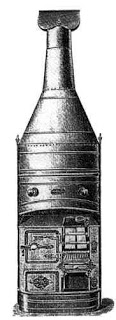 Inside the wagon the atmosphere is snug and homely, and the finer vans have an almost regal splendor. Almost everything one needs is to hand. Even in winter you need never be cold. The fire in the stove, if built up with windows closed for half an hour, will so heat the rails near the roof that they will be too hot to hold. One of the Coopers once claimed that he could bake a cake in his van by stoking up the fire, shutting the windows, and leaving the mixture in the tin on the table!
Inside the wagon the atmosphere is snug and homely, and the finer vans have an almost regal splendor. Almost everything one needs is to hand. Even in winter you need never be cold. The fire in the stove, if built up with windows closed for half an hour, will so heat the rails near the roof that they will be too hot to hold. One of the Coopers once claimed that he could bake a cake in his van by stoking up the fire, shutting the windows, and leaving the mixture in the tin on the table!
Inside the wagon the cabinet work may be either dark red polished mahogany or stained pine, and the walls are grained or scumbled in light-golden brown. In the vans that have had a lot of wear and tear the original wood finish has often been painted or grained over.
Internal layout, which varies little from type to type or van to van, has not changed for a century. The basic needs of the resident are the same and, in such confined space, there is only one sensible way to meet them. The entrance is frontal and half-doored. Through it, and on your immediate left, you find a tall, narrow wardrobe and beneath it perhaps a small brush cupboard.
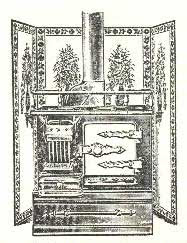 The fireplace stands next, and is always on the left as you enter, for on that side the chimney pipe is in less danger from roadside trees. From a point about two feet above the top of the stove, the fireplace is boxed in to form an airing cupboard. On the front of this cupboard and above the fireplace is a brass-railed shelf and next comes the offside window, and beneath a locker seat for two.
The fireplace stands next, and is always on the left as you enter, for on that side the chimney pipe is in less danger from roadside trees. From a point about two feet above the top of the stove, the fireplace is boxed in to form an airing cupboard. On the front of this cupboard and above the fireplace is a brass-railed shelf and next comes the offside window, and beneath a locker seat for two.
To the right, as you enter, is a bow-fronted corner cupboard; the top part , usually having glass doors, is probably used for displaying china, and the cupboard below for boots and cleaning gear. Opposite the fire there is another locker seat, and of a cold winter’s day it is good to sit there, lean back and place your stockinged feet on the brass guard rail on the front of the stove. Next to the seat is a bow-fronted chest of drawers.
Filling in the back of the van is a two-berthed bed-place, the top bunk just below the rear window, and beneath it are two sliding doors. These in the daytime shut away a second, shorter bed-place in which the children sleep. Light is supplied from a bracket oil-lamp above the chest of drawers, the surface of which is used as a table. More light may come from candles.
©From The English Gypsy Caravan by C.H. Ward-Jackson and Denis E. Harvey 1973 Edition
Quick Biscuits Gypsy Style
 A very simple recipe for biscuits. They are not light and fluffy, but they will fill an empty belly and are great for when you have nothing in your cupboard except for flour and some sour milk.
A very simple recipe for biscuits. They are not light and fluffy, but they will fill an empty belly and are great for when you have nothing in your cupboard except for flour and some sour milk.
Ingredients:
- 4 cups flour
- 1 cup sour milk
Instructions:
Put the flour into a bowl and quickly mix in the sour milk. Knead briefly on a floured surface and pat out into a thick round or square. Cut into rounds or squares. Cook on both sides on a hot floured griddle or heavy frying pan until cooked through.
Found at: Journey Folki
Granny’s Shooshi Dinner
Ingredients:
- 3 Lbs rabbit meat, cut into pieces
- 2 fresh bay leaves
- 3 stems thyme
- 2 whole cloves
- 3 onions, minced
- 1 tablespoon oil
- A few black peppercorns, crushed
- Salt
- Water and red wine
- 1 and half cups diced carrots
- 12 small white onions
- 12 small mushrooms
- 18 small potatoes
- 1 tablespoon butter, softened
- 1 tablespoon flour
- 1 tablespoon minced fresh parsley
Instructions:
Put rabbit, bay leaves, thyme, cloves, minced onion, oil, peppercorns, and salt into a large pot. Pour in sufficient water and wine to cover the ingredients in the pan. Bring to the boil, reduce heat, and simmer gently for 2 hours. Add carrots, white onions, mushrooms, and potatoes and cook, covered, until vegetables are tender, approx 25-30 minutes. Mix the butter with the flour and stir into the stew until the mixture has thickened. Simmer for 5 minutes. Sprinkle with parsley just before serving.
From: Journey Folki
Poacher’s Stew
Ingredients:
- ½ cup all purpose flour
- 1 teaspoon salt
- ¼ teaspoon pepper
- 2 pounds venison, inch pieces
- 2 tablespoon shortening or lard (not oil)
- 6 cups hot water
- 3 medium potatoes, peeled and cubed 1 inch pieces
- 1 medium turnip, peeled and cubed 1 inch pieces
- 4 medium carrots, peeled and cubed 1 inch pieces
- 1 bell pepper, ¼ inch strips (optional)
- 4 stalks of celery, cubed 1inch pieces
- ½ cup diced sweet onion
- 1 pound small fresh white button mushrooms cut in half
- 1 tablespoon salt
- 2 beef bouillon cubes
- 1 bay leaf
Mix flour, salt, and pepper. Coat the meat with the flour mixture. Melt shortening in heavy cast iron Dutch oven pot; brown meat thoroughly. Add water, heat to boiling. Reduce heat; cover and simmer about 2 hours. Stir in remaining ingredients. Simmer 30-45 minutes or until vegetables are tender.
To thicken stew: Shake 1 cup cold water and ¼ cup flour in a covered jar until well blended. Stirring stew constantly add the water/flour mix. Heat to boiling and boil for 2 minutes, continuing to stir constantly. Remove bay leaf before serving
Best if served with fresh rolls or fresh bread.
Jugged Kaunengro
Jugged Kaunengro is a traditional Romany recipe for hare or rabbit stew.
- 2 tablespoons flour
- Salt and pepper
- 1 hare, jointed
- 3 and a quarter cups strong stock, hot
- 1 lemon, peeled and sliced
- 1 onion, stuck with 3 cloves
- 12 black peppercorns
- 2 tablespoons butter
- 1/4 cup flour
- 1 cup of red wine
Instructions:
Season the flour with salt and pepper. Dredge the joints with the seasoned flour. Put the hare into the stew jar with the hot stock, lemon onion, and peppercorns. Cover the jar tightly and stand it in a deep pan of cold water. Bring this to the boil and simmer for 3-4 hours (depending on the age of the hare). Remove the hare from the jar and keep hot. Knead the butter and flour together and stir into the stock with wine. Heat the sauce, stirring until smooth and thick.
From: Journey Folki
